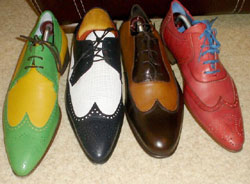Is The Congolese ‘Sapologie’ A Positive Take On Daily Struggle?
The history of these African Gentlemen can be traced back to the 19th century when the Republic of the Congo was a French colony. Some colonial masters would pay their servants in used clothes, and those servants would make a show of wearing their masters clothes on Sundays. But it’s after the independence in 1960 that the movement really took off, when Congolese students in Paris came back to their home country wearing the latest Western fashions trends. In the 1970s, popular musician Papa Wemba formed the SAPE “Société des Ambianceurs et Persons Élégants,” promoting this new lifestyle in its music videos. To this day the members of the SAPE are still part of a strong movement, gathering on Sundays to show off their latest fashion purchase.
Their style is more than just a flamboyant trend, it’s a way of life. It reflects the multicultural influences of African history and cultural syncretism. This elegance and extravagance might also be an escape from political and economical problems, a positive take on daily struggle. Nowadays Sapology has conquered the streets of Paris neighborhoods like Barbes and la Goutte d’Or and Matongé in Bruxelles. Numerous European photographers have documented the movement like Italian photographer Daniele Tamagni in his book “Gentleman of Bacongo” (with a foreword by Paul Smith).

Images by Daniele Tamagni from the book “Gentleman of Bacongo”.
https://youtu.be/a0uLJC3AcPA




